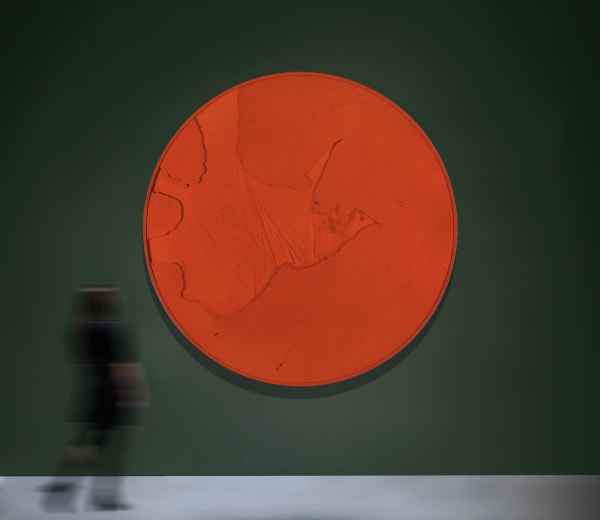Biography
"The work of Chiggio was born from an intense dynamic of movements, from a kinesiology, in which lines, surfaces, directions, points of view alternate: real space overturns into virtual space and vice versa." - Silvia Pegoraro
Ennio Ludovico Chiggio (Naples 1938 - Padua 2020) carried out technical studies and, later, artistic studies in Venice, where he inconsistently attended the Academy and the Faculty of Architecture. In 1957, he began to paint. In 1959, in Padua, he founded the Enne Group along with Biasi, Costa, Landi and Massironi, where he worked in the field of kinetic images, studying light interference and motion changes. He defined the operational scope in an increasingly precise manner by creating "objects" obtained by folding and cutting black cardboard, as a perceptual material structure capable of going beyond the pictorial randomness of an informal painting. The activities carried out within the group became more intense, with a gradual awareness that these object-works were capable of modifying artistic learning and use according to the theories of form, information and quantum mechanics. The group, around 1961, referred to its visual objects as "Opera Aperta” (open work), according to a definition given by Umberto Eco, and with increasing accuracy highlights the theories of programmed and kinetic art, with the support of art historians Giulio Carlo Argan and Umbro Apollonio. As for Chiggio’s personal interests, he also began to open up to the issues of visual poetry, photographic concretism and experimental music.
In 1964, in Padua, together with Teresa Rampazzi he founded the experimental phonology group NPS (Nuove Proposte Sonore) for the production of sound objects (electronic music). He opened a studio with equipment for producing synthetic sound events. Some NPS objects by Chiggio act as a sound space both in the section of the Enne Group at the 32nd Venice Biennale in 1964 and in the retrospective exhibition at the Museum of Modern Art in Lodz in 1967.
After 1965, when the Enne Group disbanded, Chiggio, who had become increasingly critical of the art market, carried on researching in the laboratory, also dealing with design and graphic design. After 1967, he felt the need to go beyond the production of objects limited only to optical-perceptual use in order to engage in body kinesis and the various phenomena of the body. In the 1970s, he designed many environments and, in 1972, together with Costa, Landi and Massironi, he created the collective work Infodesign, focused on environmental research and on the interest in radical trends in design, later exhibited at the Eurodomus exhibition in Turin, curated by Giò Ponti.
Between the 1970s and 1980s, Chiggio pursued his individual research by focusing his perceptual investigations onto structures defined by alternating White/Red fields, capable of modulating any surface through scans that destabilised the perceived formal solid.
From 1978 to 1989, he began lecturing as a professor of Industrial Design and Aesthetics at the Venice Academy of Fine Arts and as a visiting professor at the Universities of Venice, Florence and Padua. In Padua in 1996 he opened the multi-media research workshop Embtool where he continued with his computer musical researches and developed projects inspired by the relationship between the most recent mathematical models and artistic expression.
Works
Exhibitions
-

Ennio L. Chiggio
Oscillations Dynamiques 10 Oct - 30 Nov 2024Espace Meyer Zafra is pleased to dedicate to the Italian artist, Ennio Ludovico Chiggio , his first solo exhibition in France, Oscillations Dynamiques . From October 10 to November 30,...Read more -

The 100th Show
29 May - 28 Jun 2024Espace Meyer Zafra is pleased to present “The 100th Show”, the 100th show at the gallery bringing together the works of Marina Apollonio, Ennio L. Chiggio, Alexis Hayère, Piotr Kowalski,...Read more -

Mouvement et Déplacement
23 Dec 2022 - 23 Feb 2023Espace Meyer Zafra is pleased to present «Movement and Displacement», a collective exhibition bringing together the works of kinetic artists from Europe and Latin America. Although this movement brings together...Read more -

Déplacements
15 Jul - 29 Sep 2021“In an era filled with ever greater speed, ever-surpassed records; in the air, on water or on land, and with limits, such as the sound barrier, ever more briskly crossed,...Read more
Off-Site
-

Art Uncorked - Sunny Isles
APOLLONIO / ARDEN QUIN / CABALLERO / CHIGGIO / CRUZ-DIEZ / GALVAO / KOWALSKI / MERIDA / SALAZAR / SCHUR 1 - 17 Dec 2025During the Art Basel Miami week, Galerie Meyer Zafra is pleased to present an exclusive art exhibition in collaboration with the city of Sunny Isles....Read more -

Art Miami 2024
Booth AM314, Miami, USA 3 - 8 Dec 2024Espace Meyer Zafra is pleased to present our Booth AM314 for Art Miami Fair 2024. Central to our presentation is Grazia Varisco - Schema Luminoso...Read more -

Art Miami
Miami, USA 5 - 9 Dec 2023Espace Meyer Zafra is pleased to present our Booth AM312 for Art Miami Fair 2023. Central to our presentation is Jesus Rafael Soto ’s 1994...Read more







